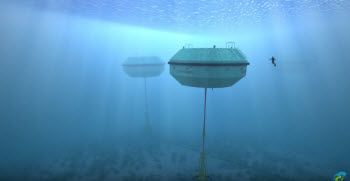Carnegie Wave Energy Designs and Builds the World’s First Operating Wave Farm with Model-Based Design
Uses MATLAB and Simulink to generate clean energy from ocean waves
Natick, Mass. - (16 Sep 2015)

MathWorks today announced that Carnegie Wave Energy has used Model-Based Design to design and build the world’s only operating wave farm. MATLAB and Simulink enabled Carnegie Wave Energy’s (Carnegie) engineers to develop unique technology for generating clean electric power from the ocean’s waves.
As part of the Perth Wave Energy Project (PWEP), Carnegie needed to demonstrate the viability of its CETO technology, which generates power from ocean swells via submerged buoys. Engineers needed to analyze loads placed on mechanical components and to estimate energy output without building a scale model of the entire system. The team used Simulink and SimHydraulics to model the wave energy system, including hydraulic and electromechanical components, which minimized scale testing and offered critical design insights. MATLAB helped to analyze and visualize simulation and test data, and also accelerated sensitivity studies.
“We can’t afford the time and expense of building and analyzing multiple physical prototypes,” said Jonathan Fiévez, Chief Technology Officer at Carnegie. “Instead, we put the effort into virtual prototyping and getting the design right in Simulink. Simulation reduces risk and fosters innovation because we can use it to quickly test novel ideas.”
“As companies work on technology to help generate clean energy, they need innovative ways to prove the systems they design will work --- without investing resources in building out a full scale model that may be far from final,” said Graham Dudgeon, Energy Industry Manager, MathWorks. “With Model-Based Design, companies can iterate on and test virtual prototypes to quickly arrive at the most successful mix of components and models within the design.”
Simulink was used to simulate a virtual prototype of the CETO 5 technology, where pumps actuated by the motion of the 11-meter-in-diameter buoys pressurize water to drive hydroelectric conversion devices, generating up to 240 kW of power per unit. After analyzing test result data in MATLAB to validate their models, engineers found that initial tests suggest a strong correlation between the modeled and measured results. Carnegie is currently working on CETO 6, which has a targeted power output of 1 MW per buoy and will be located offshore of Garden Island, Western Australia.
About MathWorks
MathWorks is the leading developer of mathematical computing software. MATLAB, the language of technical computing, is a programming environment for algorithm development, data analysis, visualization, and numeric computation. Simulink is a graphical environment for simulation and Model-Based Design for multidomain dynamic and embedded systems. Engineers and scientists worldwide rely on these product families to accelerate the pace of discovery, innovation, and development in automotive, aerospace, electronics, financial services, biotech-pharmaceutical, and other industries. MATLAB and Simulink are also fundamental teaching and research tools in the world's universities and learning institutions. Founded in 1984, MathWorks employs more than 3000 people in 15 countries, with headquarters in Natick, Massachusetts, USA. For additional information, visit mathworks.com.
MATLAB and Simulink are registered trademarks of The MathWorks, Inc. See mathworks.com/trademarks for a list of additional trademarks. Other product or brand names may be trademarks or registered trademarks of their respective holders.
